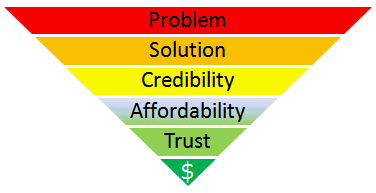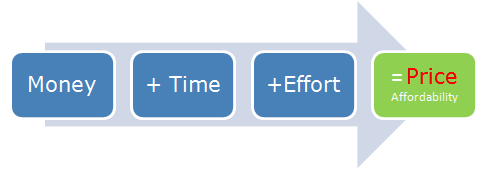The Missing Link To Writing Effective Ad Copy
Search Engine Marketers generally know how to advantageously apply HTML tags, create focused content, and build link equity for positioning Web sites with an eye toward reaching their ranking objectives. But, in regards to online marketing in general, there's one little 'ole-school' piece of homework that most SEO's entirely overlook — they neglect to interview their target customers!
Why is this important? ...because you absolutely must,
find out what they want!
...never mind what you think they want.
It doesn't take a marketing genius to know that success depends on getting the most important details right. Leave any one of the essential ingredients out of the mix and your 'salesmanship in print' falls flat. Once that premise is understood, it's easy to see why the place to start is with interviewing customers. After all, how else could you possibly 'get into their heads?'
You simply must understand their motivations, desires, likes, dislikes, expectations, problems, perceptions, misunderstandings, and wants if ever you expect to write effective sales copy!
Amatuer Web marketers typically guess and test, guess and test, guess and test (ad nauseam)—all the while telling prospects what they need in presentations peppered with lofty achievements, mission statements, and well-meaning pontifications intended solely to impress a hardly caring and hardly captive audience armed with itchy fingers that click-away at the first hint of tedium.
Customers, of course, buy what they want! ...not necessarily what they need. And, frankly, they care little, if at all, about the achievements and goals of the companies they buy from. Even trust is a non-issue until after they are four-fifths (80%) sold—at which time it becomes paramount! ...but not until then.
But, hey, don't take my word for it—start interviewing your customers and find out for yourself how little they care about you or your company as they expound enthusiastically upon what THEY want (selfish bastards;-).
From $500 start-up to nearly $2-billion-a-year in sales
Perhaps you've heard the story of Tom Monaghan. Back in 1960, when Tom was 23, he bought a pizza business for $500. As Tom struggled to bring the business along, there came a time when he inquired as to what it would take to go 'big-time' — to compete with the giants in the pizza business. The answer he received was (something like) 7 years and 10 million dollars to elevate his fledgling pizza business into the ranks of the top three. The problem was, however, Tom didn't have that kind of money nor did he wish to wait so many years.
Besides, Tom had another idea. It was simple really. You see, Tom had spent time in his pizza shop talking to his customers and listening. Tom allowed them to tell him what they wanted in regards to pizza. In a short time he learned his customers wanted their pizza...
- fresh
- hot
- fast
- but, most of all — delivered!
- ...and, they wanted a guarantee!
That's right, Tom enlisted his customers in the process of crafting what quickly became one of the most successful unique selling propositions (USP) of all time...
Dominoes delivers fresh hot pizza in 30 minutes or less
...or else it's free!
Now, had Tom been like most (internet) marketers he might have guessed what his customers wanted. He may very well have guessed they wanted...
- the lowest cost (wrong!)
- the best taste (wrong!)
- the finest ingredients (wrong!)
- the friendliest service (wrong!)
- the fanciest eatery (wrong!)
Nope! ...they wanted their pizza delivered. And, they wanted it hot, fresh, and quick! ...with a guarantee. And, Tom did not guess. He knew what they wanted because he asked the right people—his actual bona-fide, money-in-hand, hungry customers. You should do the same and accept no imitations (i.e., forget about focus groups).
The formula for 'the asking'
Ok, you say, 'ask the customer' — what could possibly be simpler? ...guess again. There's a science to asking questions. Call it a formula. If you ask the wrong questions you'll get the wrong answers. And, if you ask at the wrong time you'll get the wrong answers. And since we all know that wrong answers can lead to very bad (think expensive) mistakes, let's take a few minutes to dissect the components of a sale in our quest to determine how best to find the right answers.
Typically speaking, the sales process must filter through each one of these well-traversed levels of this inverted pryamid...

In other words...
- The customer has a problem, is aware of the problem and has an interest in solving the problem.
- The customer is somehow made aware that you have a solution.
- The customer believes your solution will work. In the mind of the customer, your solution is credible and your customers sees your solution as THE solution. In other words, your story sounds 'right' to the customer.
Your solution is affordable in the mind of the customer. This means that the money+time+effort you are asking them to "spend" is less than the value of what they'll gain from having their problem solved.
For instance, when buying a car, the value of the money+time+effort is outweighed (in the customer's mind) by the value of the benefits derived from owning the car—thus making that car affordable to that particular customer.

And the elements that compose price are what determines affordability.
- The final hurdle in the race to tran$action is trust. Having satisfied the preceding conditions, the customer looks to determine whether the seller is trustworthy. Once it becomes settled (in the mind of the customer) that you (your company, service, etc.) has the ability, means, and integrity to deliver on the promise, then and only then will...
- a transaction (you know, the sale, the money part) culminate as the natural outworking of the formula.
These 5 steps, culminating in the sixth (i.e., the transaction), is what's typically referred to as the sales process.
It should be especially noted that it's premature to enter into any single one of these levels until the preceding level has been satisfactorily completed in the mind of the customer. In other words...
- To introduce a solution to a customer before they're aware of the problem will generally doom the sale.
- Attempts to show affordability prior to establishing the solution's credibility also torpedos the transaction.
- And, attempts to establish trust prior to settling the problem, solution, credibility, affordability issues can lend a whiff of snake-oil to even the most well-meaning proposals.
Why 'lowest price' often doesn't actually sell
The fact the sales process must follow an orderly progression explains why 'lowest price' frequently fails to sell. Many times the customer lacks conviction your solution will work...or is unaware the problem even exists.
Marketing plans that rely on lowest price presuppose the first three levels — i.e., problem, solution, and credibility — have already been satisfactorily traversed in the customer's mind. Only then is the customer logically able to shop for that 'lowest price' (i.e., best affordability).
Then, in such cases, if the customer agrees with your affordability presentation and satisfactorily proceeds beyond the trust level, a transaction (sale) will predictably follow as the natural outworking of the sales process.
In fact, once the decending pyramid levels are traversed in orderly fashion, and each to the satisfaction of the customer, a transaction (sale) ensues as surely as the numeral 4 will always result from the natural outworking of the mathematical equation 2+2.
Therefore, professional marketers would be wise to realize that 'lowest price' succeeds only when your target customer has already...
- identified the problem,
- found your solution,
- and believes your solution will solve their problem.
In other words, lowest price assumes the customer is already a level four prospect who is shopping price. However, when such an assumption is wrong, it helps explain why prospects are unresponsive to lowest price sales pitches. Of course, the transaction could also be getting hung-up on (level five) trust issues.
Therefore, you must first determine the mind-set of your customers
When interviewing customers, try to determine what level they're at when they arrive at the threshold of your sales presentation. Remember, the purpose of interviewing is to gain insights that will allow you to write effective sales copy. Therefore, strive to determine your typical customer's state-of-mind (i.e., level) and ask questions designed to help you gain such insight. That's why we call this process getting into the customer's head.
Your challenge is to join their internal conversation—that discussion they are having with themselves as they traverse the five levels—as seamlessly as possible. In order to do this, you simply must learn what they are thinking at the moment they initiate contact with your services.
In the case of our Pizza example, Tom knew his customers were already hungry and safely assumed they had already decided on pizza as the solution to their hunger problem. After all, that's why they were in Tom's pizza store.
Whatever the process, Tom's customers had quickly and perhaps unconsciously traversed the first three levels of the sales process without him. Tom learned from his customers that their critical decision-making point was at the affordability level. Now, remember the components that comprise affordability?
Money+Time+Effort=Affordability
In the process of interviewing his customers, Tom discovered they wanted their pizza to be more affordable in terms of time and effort but not necessarily in terms of money. And this multi-billion dollar flash of insight came from asking his customers the right questions at the right time—when they were in the buying mind-set. As the saying goes, timing is everything. It is how you ask, who you ask and when you ask.
So, let's look at the proposition Tom developed with the aid of his customers...
- Dominoes delivers fresh, hot pizza
...he already knew they were hungry and that pizza was their credible solution to the problem. Tom knew his target audience had already passed through the first three levels of the sales process. They initiated contact with their mindset on the fourth level of the sales pyramid—affordability.
Now (the brilliant part), while competitors assumed that the money element was the key to the affordability equation, Tom discovered (by asking his customers) that time and effort were the more important elements of the affordability equation leading to the $ale at the tip of our inverted pyramid.
Therefore, by reducing time and effort, thereby increasing affordability, all that was needed to close the sale was a believable guarantee to instill trust...
- ...in 30 minutes or less—or else it's free!
Here's the point...
This intricate breakdown of the sales process is intended to help you see, no matter what business you are in, that your average customer enters your "store" (virtual or otherwise) in an identifiable state of mind that corresponds to the levels illustrated in our inverted pyramid. To write effective sales copy you must learn which level in the sales-pyramid your typical customer begins with when they arrive at your online doorstep. That's the point at which you must seamlessly join their internal conversation, bonding in the common goal of jointly crafting a believable, affordable and trustworthy "solution" to their problem.
And the only way to do all that is to ask!
Question everything. Question everyone. Question yourself—Always!
![]()
Stephen Mahaney — Founder
Planet Ocean Communications, Inc.
